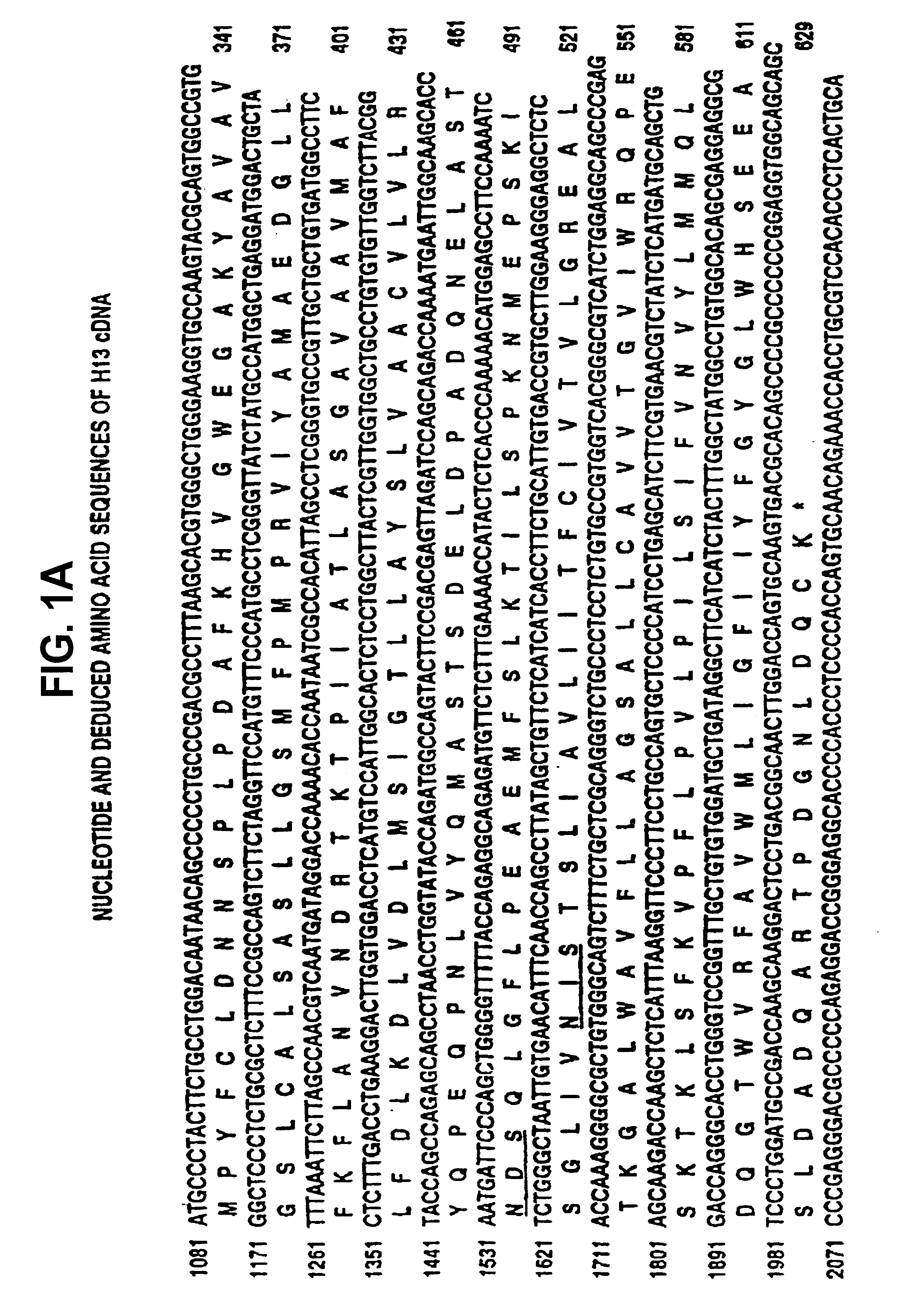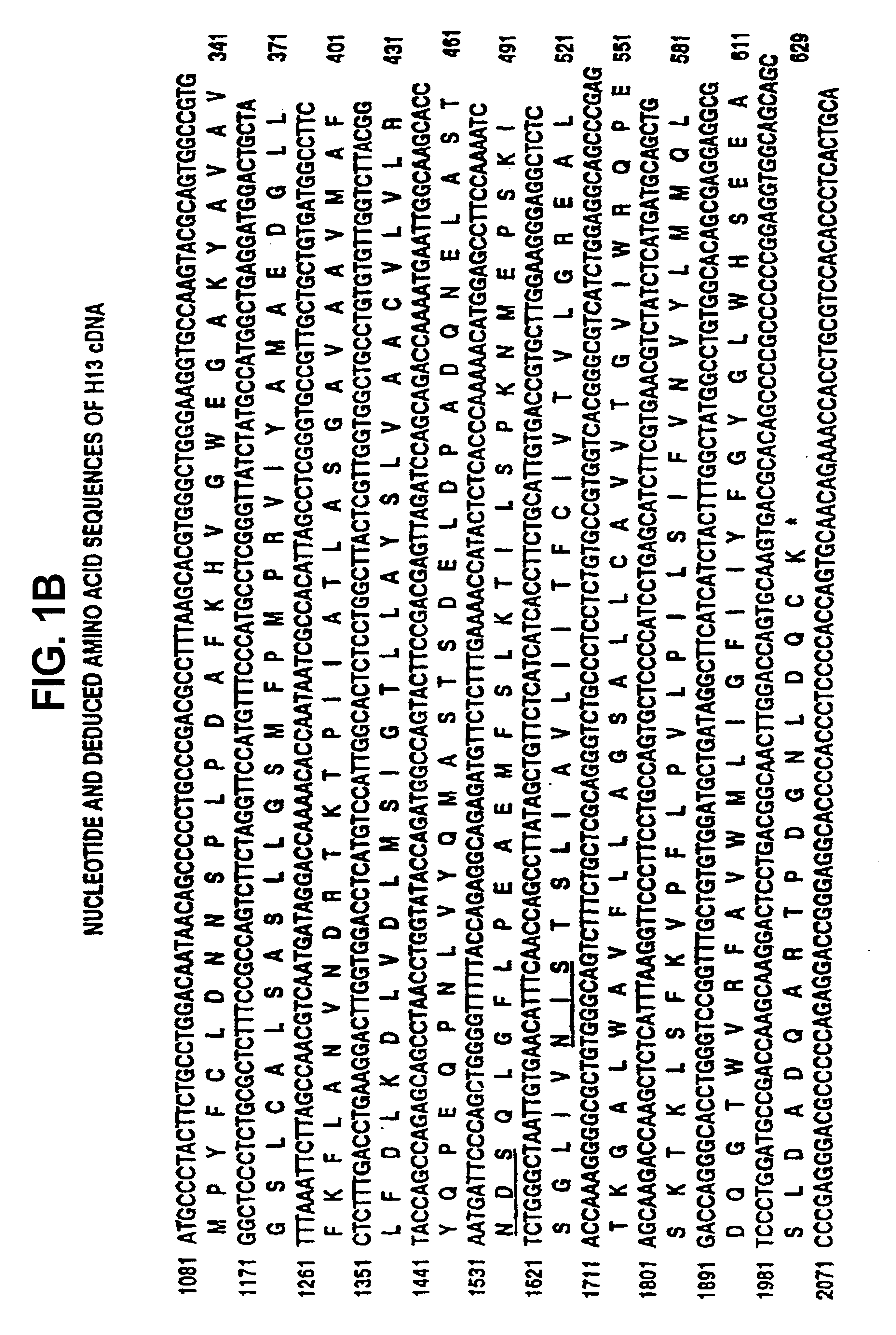Chimeric viral receptor polypeptides, human viral receptor polypeptides and uses thereof
a technology of human and chimeric viruses, applied in the field of chimeric viral receptor polypeptides and human viral receptor polypeptides, can solve the problems of monoclonal antibodies suffering from the problem of immunogenicity, cell specific delivery of therapeutic or diagnostic agents in animals and human patients, and lack of effective dosage delivery to target cells
- Summary
- Abstract
- Description
- Claims
- Application Information
AI Technical Summary
Benefits of technology
Problems solved by technology
Method used
Image
Examples
example i
General Materials and Methods Cell Lines
[0232]The following cell lines were used in the studies described below: CCL120 (ATCC# CCL120), a human B lymphoblastoid cell line; CCL110 (CEM, ATCC# CCL119), a human T lymphoblastoid cell line; SupT1, a human non-Hodgkin's T lymphoma cell line; H9, a single cell clone derived from HUT78, a human cutaneous T cell lymphoma cell line; MOLT4 (ATCC# CRL1582), a human acute lymphoblastic leukemia cell line; HOS (ATCC# CRL1543), a human osteosarcoma cell line; HeLa (ATCC# CCL2), a human epithelioid carcinoma cell line; CHO-K1 (ATCC #61), a Chinese hamster ovary cell line; B10T6R, a radiation-induced thymoma of B10.T(6R) mice; and RL12, a radiation-induced thymoma of C57BL / 6Ka mice.
Screening
[0233]Human CEM and HUT 78 T-cell CDNA library (lambda gtll) was obtained from Clontech Laboratories Inc. (Palo Alto, Calif.). The human lymphocyte cosmid library (pWE15) was obtained from Stratagene (LaJolla, Calif.). The libraries were screened by the method of...
example ii
DNA and Predicted Protein Sequence of H13
[0237]The complete nucleotide sequence of H13 (SEQ ID NO:7) including non-coding sequences at the 5′ and 3′ end of the coding sequence are shown in FIG. 1. This sequence includes the partial sequence originally obtained from clone 7-2 (SEQ ID NO:1); nucleotide 1-6 and 1099-1102 of SEQ ID NO:1 were originally incorrectly determined. FIG. 1 also shows the complete amino acid sequence predicted from the nucleotide sequence (SEQ ID NO:8). This sequence includes the originally described partial amino acid sequence (SEQ ID NO:2) with the exception of the N-terminal Pro-Gly and the C-terminal Pro, which were originally incorrectly predicted iron the nucleotide sequence.
[0238]The nucleotide sequence comparison between H13, and ERR is shown in FIG. 2 and the amino acid sequence comparison of H13, ERR and TEA is shown in FIG. 3.
[0239]The homology between the compared sequences is very high, for example 87.6% homology between H13 and ERR DNA, and 52.3% ...
example iii
Presence and Expression of the H13 Gene in Human Cells
[0240]By Southern analysis of DNA taken from cells of various species, it was shown that DNA capable of hybridizing with a murine ERR cDNA probe (FIG. 4) and with the H13 cDNA (FIG. 5) was present in cells of 5 human cell lines, including CCL120, CCL119, SupT1, H-9 and MOLT-4, and also in hamster cells (CHO-K1) and murine cells (normal BALB / c mouse thymocytes). H13 gene expression was examined using Northern analysis, using the H13 cDNA probe. The probe detected a transcript of approximately 9 kb in RNA from HeLa, SupT1, HOS and CCL119 cells (FIG. 6). This RNA could also be detected using a murine ERR cDNA probe (FIG. 7).
PUM
| Property | Measurement | Unit |
|---|---|---|
| concentration | aaaaa | aaaaa |
| concentration | aaaaa | aaaaa |
| physical | aaaaa | aaaaa |
Abstract
Description
Claims
Application Information
 Login to View More
Login to View More - R&D
- Intellectual Property
- Life Sciences
- Materials
- Tech Scout
- Unparalleled Data Quality
- Higher Quality Content
- 60% Fewer Hallucinations
Browse by: Latest US Patents, China's latest patents, Technical Efficacy Thesaurus, Application Domain, Technology Topic, Popular Technical Reports.
© 2025 PatSnap. All rights reserved.Legal|Privacy policy|Modern Slavery Act Transparency Statement|Sitemap|About US| Contact US: help@patsnap.com



